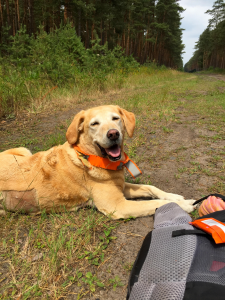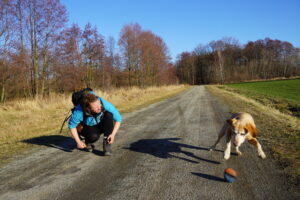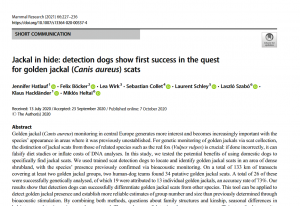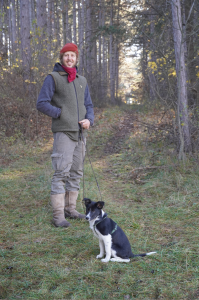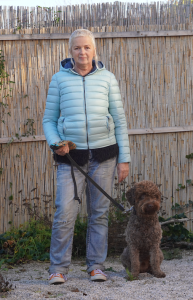IN MEMORIAM – MOLLY
Molly war die Seniorin in der Runde und ein alter „Hase“ im Suchen von Anwesenheitszeichen. Seit 2018 war sie im aktiven Einsatz zur Suche von Hinweisen (Kot, Haare, Urin, Blut, Risse) für das Monitoring von Wölfen. Neben ihrem täglichen Einsatz in Sachsen und Brandenburg, wurde sich bereits erfolgreich im Wolfsmonitoring in Niedersachsen, Österreich, der Schweiz und der Slowakei eingesetzt. Mit Ihrer Hundeführerin Lea hatte Molly nicht nur den Master Wildtierökologie und Wildtiermanagement abgeschlossen, sondern war schon in so manchen Gebieten im Dienste der Forschung über Stock und Stein gelaufen. Sie hat aber auch beherrscht nach Goldschakal Losung zu suchen und in unseren bilateralen Projekten mit Ungarn und Polen ihr Können bewiesen.
Dieses eingespielte Team ließ sich bei ihrer Suche wirklich nicht leicht aus der Ruhe bringen. Molly war eine unglaublich sanftmütige, gelassene aber auch immer wieder fröhliche Hündin. Es war wunderschön den beiden beim Arbeiten zuzusehen. Lea brauchte nur ein kleines (für Menschen aber kaum sichtbares) Handzeichen zu geben und Molly wusste gleich was zu tun war.
Danke dass du uns begleitet hast, wir vermissen dich sehr!
Spürhunde auf der Suche nach Goldschakal Losung
Hunde sind in der Suche um einiges effizienter als wir Menschen und die feine Nase kann den Kot des Schakals leicht von dem eines Fuchs oder Hundes unterscheiden. Deshalb werden für das Goldschakal Projekt zwei Spürhunde speziell für den Einsatz in Österreich ausgebildet – um nach Losung zu suchen. Die Losung kann weiter Aufschluss über die mögliche Anwesenheit von Goldschakalen im Untersuchungsgebiet und weiterführend über die familiären Strukturen der Tiere geben.
Projekt Spürhunde Österreich – Ungarn
U
First results are summarised here:
Erste Goldschakal-Spürhunde werden in Österreich ausgebildet um auf Goldschakal – Losungssuche zu gehen.
Stefan Knöpfer und Robin Hood
Stefan Knöpfer ist ausgebildeter Tierpfleger, Leiter von ORNITHOCLIMBING, Ornithologe und seit 2018 zertifizierter Spürhunde-Führer. Seit 2019 arbeitet er mit seinem Spürhund „Chilly“ für Birdlife im Einsatzfeld „Bird-crime“. Die beiden suchen Vogelkadaver; seit 2020 auch im Kollisions-Monitoring unter Windrädern im Osten Österreichs.
Der Bordercollie „Robin Hood“ ist seit Anfang November 2020 bei Stefan. Früh schon hat sich der Welpe für die Suche interessiert, da er sie immer wieder bei Übungseinsätzen von Chilly miterlebt. Bei der Ausbildung zum Spürhund steht Robin Hood natürlich noch am Anfang, aber Stefan hat Großes mit Robin vor: Hüten und Suchen. Hüten der eigenen Ziegenherde und Suchen nach Tierkadavern sowie Goldschakal Losung!
Doris Kriegsherr und Giorgina
Zu Doris kam die Lagotto Romagnolo Hündin Giorgina vor sieben Jahren. Sie stammt aus Italien und das Suchen wurde ihr bereits in die Wiege/ins Körbchen gelegt, da beide Eltern professionelle Trüffelsuchhunde sind. Nach einer fundierten Ausbildung zum Trüffelsuchhund schauten sich Doris und Giorgina nach einer neuen Herausforderung um und lernten die NATURSCHUTZHUNDE kennen – damit begann einen intensive und spannende Zeit. Es folgte eine Ausbildung und Zertifizierung zum Kadaverspürhund und seit Juli 2020 sind die beiden für das Kollisionsmonitoring bei Windkraftanlagen regelmäßig aktiv. Da Giorgina am liebsten stundenlang im Wald unterwegs ist, bleibt auch die Suche nach Trüffeln ein wichtiger Teil der gemeinsamen Arbeit. Die Ausbildung zum Goldschakalspürhund begann im Herbst 2020, die Zertifizierung erfolgte im Mai 2021 – und da sowohl Doris und Giorgina als auch Goldschakale im Osten Österreichs „wohnen“ können sie für einen künftigen Einsatz schnell im geplanten Untersuchungsgebiet sein.
Die Ergebnisse der letzte Studie aus dem paper Hatlauf et al (2021) zusmamengefasst:
Abstract
Golden jackal (Canis aureus moreoticus Geoffroy, 1835) monitoring in central Europe gets more critical with their appearance in new, previously unestablished areas. Compared to research of other mammals, the genetic monitoring of golden jackals via the collection of scats entails challenges. The discrimination of golden jackal scat to other related species such as the red fox (Vulpes vulpes) is crucial and can cause false results in diet analyses or high costs in DNA-analyses. In this study we tested the benefit of using domestic dogs to find scats and distinguish between species. Therefore, we used trained scat detection dogs to locate and identify golden jackal scats in an area of dense shrubland, where golden jackals were previously confirmed with bioacoustic monitoring. On a total 133 km of transects with a minimum of two golden jackal groups, two human-dog teams found 34 scats, of which 26 could be successfully analysed and 19 were genetically attributed to golden jackals. Besides confirming or improving the estimates from bioacoustic stimulation, the inclusion of detection dogs provides a promising additional tool that allows a more detailed research and new knowledge and ensures answers to diverse questions in the long-term.
Introduction
During the past decades, golden jackals (Canis aureus) are spreading within Europe and have started to appear in areas where they have not previously occurred (Arnold et al. 2012; Trouwborst et al. 2015; Krofel et al. 2017). Besides the source populations within Europe, the Balkans, golden jackals have been recorded much further to the West and North – France, Denmark, or most recently even Finland (Rutkowski et al. 2015; Bouchet 2017, Koistinen 2019). The scientific as well as the public interest raised specifically given conservation and management aspects (Rutkowski et al. 2015; Spassov and Acosta-Pankov 2019). Golden jackals were mentioned both as agricultural pest on one hand, because of possible depredation of small livestock, as well as possible pest control themselves on the other hand, because of their main food being for example rodents (Brooks et al. 1993; Raichev et al. 2013). Confirmed attacks on (mostly young or elderly) sheep (Fanin et al. 2018) point out potential adaptations in management or livestock protection. The jackals´ flexible diet is sometimes based on anthropogenic resources, like remains from big game hunting or from slaughterhouses (Lanszki et al. 2015; Ćirović et al. 2016) and might therefor need to lead to changes in waste management or in hunting practices. Several topics (also conservation) considering golden jackals in Europe are still poorly studied (Alvares et al. 2019), and fear of the unknown should be considered (Meran 2015). As the request for knowledge is increasing, essential monitoring to investigate the golden jackal´s current distribution and dispersal in the future, is getting more relevant and necessary.
For these purposes, different methods are already in use, e.g.: camera trapping (Pyšková et al. 2016; Farkas et al. 2018), bioacoustic surveys (Giannatos et al. 2005; Krofel 2009; Acosta-Pankov et al. 2018) or genetic population analyses and scat analyses (Rutkowski et al. 2015; Lanszki et al. 2018). Whereas in the research of several species, an analysis of fresh scat provides a secure, reliable and non-invasive method to receive genetic information (Janečka et al. 2008; DeMatteo et al. 2014), the substantially overlapping food niche of closely related species (Lanszki et al. 2010; Akrim et al. 2019) complicates the morphological discrimination of scats (Foran et al. 1997, Baines et al. 2013, Spitzer et al. 2019); in some cases, only DNA-analyses can, in the end proof the species of collected, questionable scats. This investigation can be expensive if all scats in question have to be included (also the “unsure” samples). To avoid a large number of uncertain scats and unnecessary costs, research studies started to use the dog´s exceptional sense of smell, include trained domestic dogs (Canis lupus familiaris) to find and identify samples of interest. The potential of this method has been proven all over the world for various species (Vynne et al. 2011; DeMatteo et al. 2014; Orkin et al. 2016), also for successful discrimination of close related species or even individuals from the same species (Smith et al. 2003; Kerley and Salkina 2007). In contrast to this success, we presume that humans are not reliably able to discriminate golden jackal scats from close related canid species, especially in areas of coexistence (specifically with red foxes (Vulpes vulpes) that is widespread all over Europe). Moreover, in several cases, humans have a much smaller over-all detection success than dogs (Böcker 2015; Ramsey et al. 2017; Smith et al. 2010), which is an additional reason why we designed this study, to improve overall detection success. Against mentioned backdrop we moreover address the following. Besides expecting to learn more about the characteristics of golden jackal scats and the species marking behaviour, we firstly (and most importantly) assumed that in an area of previously confirmed jackal presence, trained detection dogs could reliably find, discriminate from other species, and indicate golden jackal scats to humans correctly. We secondly hypothesized that through repeated excursions in two consecutive years, it is possible to re-confirm resident golden jackals.
Methods
Study Area
We conducted present study in November 2018 (“Field Season 1”) and March 2019 (“Field Season 2”) near the Hungarian Lake Velence in the administrative division of Fejér (see figure 1). With 1354 ha and extensive reed covers, the Ramsar site “Velence and Dinnyés Nature conservation area” comprises part of the study ground. Bioacoustic surveys and official hunting bag data previously confirmed the presence of golden jackals in this region (Pallos 2016; Heltai et al. 2018; Hungarian Game Management Database 2020). Besides the affirmed occurrence of golden jackals, the species composition in this conservation area has a wide range. It is comprised of reptiles (for example swamp turtle Pseudemydura umbrina or water snakes Natricinae), amphibians (newts and several types of frogs), a diverse range of 300 bird species (32 of which nest here), mammals (the exceptionally protected Eurasian otter Lutra lutra on the western side of the lake, wild boar Sus scrofa, red deer Cervus elaphus, roe deer Capreolus capreolus, red fox Vulpes vulpes and badger Meles meles). While the presence of stray dogs was occasionally proven in the hunting area, it is still of rare occurrence.
The elevation in the study area ranges from a minimum of 140 m above sea level to a maximum of 281 m a.s.l (NASA JPL). The CCI landcover dataset (ESA 2017) shows “Herbaceous” as being the leading category in over 30 % and as second most occurring “Cropland (rainfed)”. Main crops in both areas are maize, soybeans, rapeseeds and wheat (OneSoil 2018). Whereas in the more northern area broadleaved trees are dominating some of the transects, in the southern area grassland is more prominent. The soil texture of both study areas is mostly comprised of loam or clay loam. The maximum snow cover in these areas is 20cm and the average precipitation in both regions is approximately 520 to 530 mm per year with low variation, and the average temperature is 11 degrees Celsius (Fick and Hijmans 2017).
Figure 1: Study area with the occurring landcover categories from CORINE (EEA 2020) and transects of both teams for both seasons (dark red line), and with the nine locations of calling stations (camping sign).
Jackal presence confirmation
At the beginning of the scat detection excursions with the human-dog teams, the actual presence of golden jackals in the study area was affirmed through non-invasive bioacoustic stimulation; a widely used and accepted method to confirm jackal presence (Giannatos et al. 2005). We emitted howls at altogether nine different locations (11 calling stations; see figure 1) on two consecutive nights during field season 1. With a calculated 1 km2 buffer (Szabó et al. 2007), the covered area resembled 28.3 km2. While one howling on the second day took place in the morning at 7:00 a.m., all other howling stimulations started approximately one hour after sunset in standard weather conditions (windless, without precipitation). Howling tracks (calls) were emitted through a 55-Watt Megaphone (Vexus MEG055). At each calling station, the howling was emitted three times, with a four-minute pause in between the howls. We documented the estimated number of answering individuals, the approximate distance, and the direction of answer calls (azimuth). The density was later estimated as the number of groups and individuals per 10 km2.
Scat detection
Over a time of 1 year, two dogs were irregularly specifically trained to identify and indicate golden jackal scat. The given indication is a behaviour learned by the dog, which signals to the handler that the dog has recognized the scent of the learned target species. The trained dogs were: a female Labrador Retriever (born 2007) and a female mix breed German shepherd-Collie-Labrador Retriever (born 2011). Before being trained for the golden jackal as target species, both dogs were already experienced with the detection of the scat from wolves (Canis lupus) and regularly deployed in monitoring activities for several years. Using operant conditioning (Snijders et al. 2019), both dogs were additionally prepared to detect the smell of scats from golden jackals. The samples used for the training originated from golden jackals in captivity, to make sure that the training sessions only include certain faeces of the target species. A total of 15 different samples from individuals of both sexes and different age classes were available. The training samples were stored frozen in glass jars and thawed specifically for training. Since permanent decomposition processes influence the potential samples in the study area and therefore the scent of the target species, the training samples were also exposed to different weather conditions and different decomposition, to offer the dogs the odour of the target species as diverse as possible. After the first basic conditioning, different smells of non-target species were presented to the dogs additional to the target smell, to achieve a distinction between enticing odours and the scent of the target species. During practice, we tried to simulate the expected situation in fieldwork as realistic as possible, outdoors, and in similar landscapes. Regular repetitions of the basic training took place continuously, and before each deployment, the training was intensified.
In designing this study, we selected possible routes (transects) for the two human-dog teams (one team: dog and its handler) based on digital map material (see transects for both teams and both field seasons in figure 1). Due to the previous experience in monitoring wolves, the dogs were used to work in the field for long periods. Each dog handler had the freedom to assess the dog and its current condition and motivation and structured the search accordingly. A detailed time plan for practical fieldwork ensured that the dogs could rest after the journey to the study site and before the start of each active survey. The routes were flexibly adapted to actual circumstances during the search if required (for example, non-accessible paths). The aim was to cover the study ground as completely as possible, not utilizing areas without accessible pathways. We used only paths or path-like structures such as wood strips or mowed aisles in the reeds.
All samples collected in the study area were selected exclusively based on the indication given by the two purposefully trained dogs. Each finding was collected with gloved hands, photographically documented and measured (see protocols in the supplements). The exact GPS positions were taken with field GPS devices (Garmin eTrex series). A small (fingernail-sized) portion of each scat was preserved in 96% ethanol to allow subsequent genetic analysis. The remaining part of the samples was collected in commercial freezer bags and frozen at -15 degrees.
Genetic Analysis
DNA from scats was extracted using the QIAamp DNA Fast Stool Kit (Qiagen, Hilden, Germany) following the manufacturer’s instructions. For genetic identification of species, sex, and individual microsatellite and mitochondrial sequence analysis was applied.
We performed sequence analysis of a hypervariable domain of the mitochondrial control region (D-loop) for initial species identification (Pun et al. 2009) with the primers L15995 (Taberlet et al., 1994) and H16498 (Fumagalli et al., 1996) as well as L15995 and WdloopH (Caniglia et al. 2013). On selected samples, we additionally used primers WdloopL and WdloopH (Caniglia et al. 2013) specific for detecting the genus Canis. Sequences were compared to the NCBI GenBank via BLAST search. Sequence length varies with primers and species. For genus Canis, it is 200 to 360 bp.
In confirmed golden jackal samples, we amplified 13 unlinked autosomal microsatellite loci as well as two sex markers that are regularly used for genetic analyses in wolves and domestic dogs (Canis lupus): CPH5 (Fredholm and Winterø 1995); FH2001, FH2010, FH2017, FH2054, FH2087, FH2088, FH2097, FH2137, FH2140 and FH2161 (Francisco et al. 1996); vWF (Shibuya et al. 1994); PEZ17 (Neff et al. 1999); DBX6 and DBY7 (Seddon et al. 2005). The use of markers that are cross-amplifying among canine species such as wolves and dogs is widely spread in genetic studies on golden jackals (Zachos et al. 2009; Fabbri et al. 2014; Rutowski et al. 2015; Stronen et al. 2020). All markers were previously tested on golden jackal samples in our laboratory.
Three multiplex PCRs were performed in 10-μl reactions containing HotStarTaq Master Mix (Qiagen), 0.2 μM of each primer, 2 ng BSA, and genomic DNA. PCRs were run in a T1 plus Thermocycler (Analytik Jena, Germany) with an initial denaturation step of 95 °C for 3 min followed by 5 cycles of 94 °C for 30 s, 60 °C for 90 s and 72 °C for 60 s; another 5 cycles of 94 °C for 30 s, 58 °C for 90 s and 72 °C for 60 s; 5 cycles of 94 °C for 30 s, 54 °C for 90 s and 72 °C for 60 s; 20 cycles of 94 °C for 30 s, 54 °C for 90 s and 72 °C for 60 s; and a final extension of 72 °C for 30 min. PCR products were electrophoresed on an ABI3730 DNA Analyzer (Life Technologies GmbH, Darmstadt, Germany) and fragment sizes were determined using GeneMarker v1.90 (Softgenetics LLC, State College, Pennsylvania) by comparison to LIZ600 as an internal size standard. Every multiplex was replicated four times to account for genotyping errors (Navidi et al. 1992; Taberlet et al. 1999).
Density estimates based on scats
Golden jackal relative abundance was expressed according to the general faecal density index (FDI) values (described in Webbon et al. 2004) on the basis of found scats. We described the average faecal encounter rate per km as an indicator for the FDI and only included the human-dog-team-found and positively DNA confirmed golden jackal scats. The absolute density was not estimated as the defecation rate for wild golden jackals is not yet studied, and absolute density on the basis of canid scat is discussed to be ambiguous (Beltrán et al. 1991).
The results from the field excursion and the scat details were summarized and analysed in RStudio Version 1.1.383 (RStudio Team 2017). Furthermore, the GPS positions from the found scats, and the results from bioacoustic monitoring were combined in a map with the GIS software QGIS version 3.8 (QGIS Development Team 2019).
Results
Jackal presence confirmation
Through bioacoustic stimulation, we could reaffirm golden jackal presence in our study area: we received replies on five occasions in total, comprised of one single answer and four answers by more than two individuals; resulting in an overall sampling success effort of 45 %. We found the estimated minimum to be two territorial golden jackal groups within our acoustically studied area. Through the assumption that one group (answering in a choir) is on average comprised of 4-5 individuals, and the second assumption that one acoustic survey point on average covers an area with the radius of 1 km2 (after Szabó et al. 2007) the estimated density utilizing bioacoustic surveys in the studied area of 28.3 km2 was a minimum of 8-10 individuals, corresponding to a density of 2.8 to 3.5 individuals per 10 km2 or 0.7 groups per 10 km2.
Scat detection and DNA results
During field season 1 and field season 2 the two human-dog teams searched a total length of transects of 133.03 km for the scats of golden jackals and found 34 scats altogether (table 1; example figures and data of found scats in the supplements S3). 30 % of scats were found on path edges in raised positions, 30 % in the middle of the path, and the remaining samples on path edges, in the driving lane, or offside the paths. Out of the detected scats, 31 could be used for genetic analysis. The identification of the species was successful from 26 of the analysed samples, with 19 being golden jackal (see table 2). Further genetic analysis showed a total of 13 different individuals (8 male, 5 female), three of them were sampled twice, and two samples could not be individually discriminated (table 3).
See tables in Hatlauf et al. (2021)
Scat density and summary
For both field seasons combined, the average faecal encounter number was 0.14 golden jackal scats per kilometre, being equivalent to the relative abundance of golden jackal, according to the FDI. The FDI from field season 1 resulted in 0.12 and from field season 2 in 0.16 scats per kilometre. The individual FDI resulted in 0.1 different individuals per km. Summarized results are displayed in the map, figure 4.
Figure 4: Combined results in the surveyed area, black dots = confirmed positive golden jackal via DNA; Red line = walked transects; purple triangle = no answer within bioacoustic monitoring; red and green stars = positive howling responses within bioacoustic monitoring, white arrow = direction of answer; grid cells = indication of total count of positive golden jackal records.
Discussion and Conclusion
Using scats for non-invasive monitoring is a well-known and universal method for a variety of species (Foran et al. 1997; Baines et al. 2013; Ramsey et al. 2017). Through our study, we confirmed that detection dogs successfully found and indicated golden jackal scats, with an accuracy of 73.1%. We established that the trained detection dogs can point out the scat of golden jackals and that it is possible to overcome the uncertainty of discrimination between scats from foxes, golden jackals, and other related species. Our results support that detection dogs can discriminate between the target species and species with an assumingly high overlap in food niche and habitat. We were not able to analyse our second hypothesis in detail (loyalty to the area over the two seasons) as only one individual (a female golden jackal) was confirmed as re-occurring during both field seasons. This first assessment of possible resident individuals might in general indicate a high fluctuation of the jackal population within the study area, for example through hunting (shot individuals: n= 9 (2016), n=10 (2017), n=1 (2018), n=12 (2019)). On the other hand, overall larger than survey area- and/or changing home-range sizes, or simply dispersing individuals that were represented through our results, could be the reason of the low re-detection.
Dog training and practical experiences
Detection dogs were trained to locate and identify golden jackal scats in the wild for the first time, to our knowledge. This study was also the first practical experience in the search for golden jackal scats for the two trained dogs and their handlers. After the first excursion, both handlers described an uncertain behaviour of the dogs during the indication, compared to training situations. More experience in fieldwork could, therefore, lead to better results, which might already be indicated by the higher FDI during the second field season. Nevertheless, this higher FDI can also be the result of other previously mentioned possible influences like hunting pressure or changing territory ranges.
Besides highly degraded scats (consequently without a genetic result), we also analysed samples with ambiguous indicating behaviour from the dogs´ side to get the chance to improve the cooperation of handler and detection dog. Therefore, in addition to golden jackal scats, the genetic analyses showed Lutra lutra once, Vulpes vulpes three times, and Canis familiaris three times; in all cases, the dogs only displayed an indicating-like behaviour after further inquiry by the handlers. Pushing the dog into an expected behaviour that leads to a false indication of samples is a known risk (DeMatteo et al. 2019) and needs to be assessed by the handlers in given situation. We specifically documented shown behaviour in these uncertain situations. Due to the ability of the handlers to assess the behaviour of the dogs in unsure situations, with this additional information and the genetic details of found scats, the trainers will be able to interpret indications more efficiently in the future. The results overall presented that dogs and handlers need more practice with the new target scent with work assignments to become more confident. However, our findings allowed the main conclusion that the dogs´ first decisions were correct in all cases.
Density and future research
Besides this approximate overlapping correspondence of acoustic stimulation and scat findings, the results show that a combination of these two methods can lead to a higher amount of knowledge about local golden jackals and help to display their distribution. Some of the proven jackal scats were registered in areas without answers to acoustic stimulation. Consistent with this, where acoustic stimulation led to positive results, it was not necessarily combined with scat findings in the same area. Nevertheless, as we do not know, if answering individuals are also displayed by the found scats, more surveys are needed.
While the altogether work effort by the human-dog teams was relatively high, compared to bioacoustic surveys, 7 km and 2.88 hours of fieldwork for one positive golden jackal sample, it is a method with diverse benefits (like certainty of species, number of individuals, etc.). The hardly studied marking behaviour, for example, can be assessed in much more detail in further studies. During our investigation, we found several scats on path edges or offside the paths. Specifically, detection dogs can discover and identify hidden off-path scats, that are hard to find for humans.
Despite great advantages of genetic analysis in general, the main detriment is high costs. Therefore, preselecting the samples with the help of detection dogs, is likely to minimize unnecessary costs and is recommended. Even the use of human-dog teams itself can be arranged in a cost-efficient way (Orkin et al. 2016). Experiences with the morphological discrimination of scats from Canis lupus lupus (Reinhardt et al. 2015) and Vulpes vulpes as well as the awareness of the difficulties in the correct determination by humans of the scats even from notable different species (in body sizes and main pray like those two), actually lead to the assumption that only the help of detection dogs can guarantee more efficiency in non-invasive studies based on scats. For simply confirming golden jackal presence in an area, the sole use of the bioacoustic method still seems sufficient and more effective time-wise. Nevertheless, through the help of detection dogs, integrated in a multidisciplinary approach with bioacoustic surveys at the beginning of fieldwork, questions of family structures and kinship, seasonal differences of habitat use, and territory sizes can be answered. The regular use of detection dogs can present an efficient method to monitor golden jackals on a long-term basis and to learn more about their relations on a local as well as a global scale.
